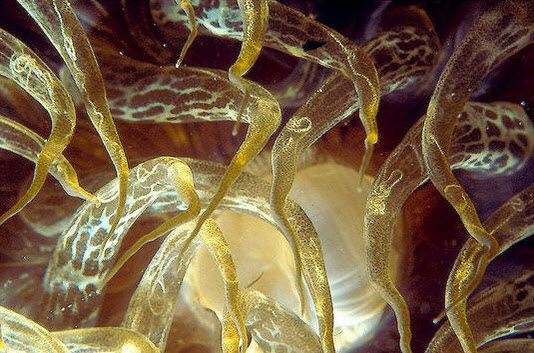
Aiptasia Anemones
What is Aiptasia
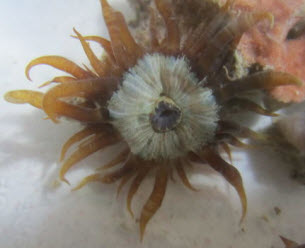
Aiptasia anemone. Picture by Smithsonian Institute.
Aiptasi sp is a type of pest anemone that infest reef aquariums and it should although beautiful be removed from an aquarium as soon as possible. The longer it takes to start treatment the worse the infection will be. Aiptasia is most often introduced to an aquarium with live rock. The most common species in aquariums is Aiptasia pallida but other species are also regularly introduced.
It is common that beginner reef keepers anxiously is observing their live rock to see what types of life it might have brought with it. One day they see a small baby polyp. The right thing to do at this point is usually to remove it since most polyp hitch hikers are either Aiptasia or the equally problematic Majano Anemone. Most reef keepers do however want to see what it develops into and before long they are the happy owners of a beautiful anemone. Fast forward in time and the reef keeper will before he knows it have a rapidly growing Aiptasia colony and start to realize that he has a problem. At this time it is a lot harder to get rid of the Aiptasia than it would have been if it had been removed straight away. It is therefore important to try to identify any polyp and anemone you see as early as possible. You can read more about identifying Aiptasia further down in the text.
In the wild Aiptasia is a common sea anemone found in temperate and tropical waters. They live in the benthic zone where they can be found growing on mangrove roots and hard surfaces. Many species of Aiptasia contain symbiotic dinoflagellate unicellular algae of the genus Symbiodinium living inside nutritive cells. The algae helps the Aiptasia by providing fats and sugars produced through photosynthesis. In return the Aiptasia provides protection and inorganic nutrients. Some species that feeds on Aiptasia such as the Berghia nudibranch absorbs these algae and benefit from the symbiotic relationship. The algae do however normally survive less than one week after having been absorbed by Berghia nudibranches.
Aiptasia species are hardy and beautiful but they are still considered aquarium pests and it is easy to see why. The Aiptasia is very fast growing and aggressive. If left alone they can quickly out compete everything else living on the live rock. They have stinger cells (filled with nematocysts ) filled with a very potent poison that cause corals and other polyp animals to retreat The Aiptasia is also capable to kill corals, shrimp, crabs, snails and even fish. It is not very common that Aiptasia kills fish or desirable invertebrates but the risk is more than serious enough to warrant their immediate removal and the risk get higher the more the Aiptasia is allowed to spread. Aiptasia stings for both offensive and defensive purposes.
Aiptasia is very hard to remove once established due to their ability to regrow from very small segments left on the rock after the removal of the poly. Each of the small segment regrows into a new polyp. Aiptasia can sometimes regrow from one single cell left on the substrate after the removal of the rest of the polyp.
Identifying Aiptasia
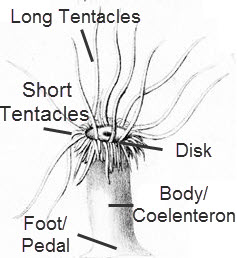 It is important to identify Aiptasia as early as possible so that treatment can start as early as possible. It is also very important to identify Aiptasia correctly if you want to use biological methods to control the Aiptasia. Berghia nudibranches will as an example only eat Aiptasia and not Majano Anemones. Another type of very common aggressive pest anemone.
It is important to identify Aiptasia as early as possible so that treatment can start as early as possible. It is also very important to identify Aiptasia correctly if you want to use biological methods to control the Aiptasia. Berghia nudibranches will as an example only eat Aiptasia and not Majano Anemones. Another type of very common aggressive pest anemone.
It can be hard to identify Aiptasia and other polyps while they are still small but once they are fully formed it gets a lot easier. It can however sometimes still be a challenge.
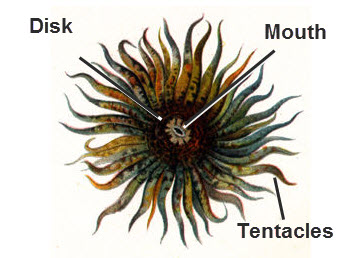 Aiptasia species looks like small palm trees with a disk of tentacles at the top. The disc contains both long and short tentacles attached at the edges of the disc. In the center of the disk is the mouth. It looks like an elongated slit. The tentacles are usually slender and have very pointed tips. If the tentacles are more chubby with bulbous tips you are most likely looking at the similar but very different Majano pest anemone. The “stalk” or the coelenteron (polyp body) as it is more correctly called of the Aiptasia can grow up to 5 cm / 2 inches long. The disk at the top can grow to be 2 cm / 3/4 inch wide.
Aiptasia species looks like small palm trees with a disk of tentacles at the top. The disc contains both long and short tentacles attached at the edges of the disc. In the center of the disk is the mouth. It looks like an elongated slit. The tentacles are usually slender and have very pointed tips. If the tentacles are more chubby with bulbous tips you are most likely looking at the similar but very different Majano pest anemone. The “stalk” or the coelenteron (polyp body) as it is more correctly called of the Aiptasia can grow up to 5 cm / 2 inches long. The disk at the top can grow to be 2 cm / 3/4 inch wide.
The coloration in the Aiptasia is caused by the dinoflagellate alga living in it. The color of the Aiptasia will hence vary with the lighting conditions under which it grows. In a well lit area Aiptasia will usually be dark to greenish brown. The tone of the Aiptasia will grow lighter the less light that is provided. This can give them a tan or even almost transparent look in low light conditions. It is common that the body of the Aiptasia features lightly marked parallel lines. These lines are however not always present. It is also not uncommon that white or light green flecks are present near the tentacles. Juveniles specimens can sometimes be entirely cover in flecks.
Aiptasia Species
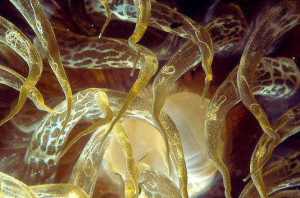
Aiptasia mutabilis – Picture also used in article header.
© Alfiero Brisotto cc2.0
The following 16 species of Aiptasia is currently accepted:
- Aiptasia californica (Carlgren, 1952)
- Aiptasia carnea (Andrès, 1881)
- Aiptasia diaphana (Rapp, 1829)
- Aiptasia erythrochila (Fischer, 1874)
- Aiptasia insignis (Carlgren, 1941)
- Aiptasia inula (Duchassaing & Michelotti, 1864)
- Aiptasia leiodactyla (Pax, 1910)
- Aiptasia mimosa (Duchassaing & Michelotti, 1864)
- Aiptasia minuta (Verrill, 1866)
- Aiptasia mutabilis (Gravenhorst, 1831)
- Aiptasia pallida (Agassiz in Verrill, 1864)
- Aiptasia parva (Carlgren, 1938)
- Aiptasia prima (Stephenson, 1918)
- Aiptasia pulchella (Carlgren, 1943)
- Aiptasia saxicola (Andrès, 1881)
- Aiptasia tagetes (Duchassaing & Michelotti, 1864)
Aiptasia Care
There are a number of reason to actively keep and care for Aiptasia. The most common reason is likely as food if you are breeding Berghia nudibranches. Berghia only eat Aiptasia and is commonly sold to control Aiptasia
If you for some reason want to actively keep and care for Aiptasia you will find it to a be a very easy and hardy anemone. That is the reason they are considered a pest. It will not require any special care to grow as long as you keep decent water quality. I do not recommend keeping any other small fish or invertebrate in aquarium where you plan to grow Aiptasia. There is always a risk that they will get killed.
Acquiring Aiptasia can sometimes be hard since no one want to have it in their aquarium. It should however usually not be to hard to get some from an infested aquarist or aquarium store. Worst case scenario you might be able to get some from one of the many Berghia sea slug breeders that sell their slugs online.
Avoid keeping species that are known to eat Aiptasia such as peppermint shrimp and butterfly fish if you want to keep Aiptasia in your aquarium.
Aiptasia Reproduction
Aiptasia can reproduce both sexually and asexually.
- Asexual reproduction
Asexual takes place through pedal laceration. This happens when a small group of cells are somehow separated from the pedal disk of the Aiptasia. These small groups of cells grows into buds. These buds will then develop mouths and tentacles of their own. A miniature Aiptasia is normally formed within a week or two from the cells being separated from the parent polyp. This polyps can release their grip on the surface and float with the waters current to colonize a new spot. Colonies of Aiptasia form and grow primarily through asexual reproduction. Sexual reproduction play a larger role in spreading them to new locations. Aiptasia can as earlier mentioned regenerate an entire new anemone from a single cell. This is why they are so hard to eradicate and why methods that only destroys the polyp without killing all the cells such as manual Aiptasia removal are so contra productive.A surprising ability in at least some Aiptasia species (A. diaphana) is that pedal laceration can produce both male and female polyps. In other words, even though the new polyps created through asexual reproduction are clones of the original poly they can still developed into different sexes. Clones can reproduce with each other through sexual reproduction. Some clones have even been shown to develop into hermaphroditic polyps. - Sexual ReproductionThe Sexual reproduction in Aiptasia works different in different species. Some species such as the common Aiptasia pallida and Aiptasia pulchella have external fertilization. Other species supposedly have internal fertilization that takes places within the Aiptasia.Lets start by having a look on sexual reproduction in Aiptasia species such as Aiptasia pallida and Aiptasia pulchella. The reproduction in these species are well researched. The Aiptasia belong to one of two genders. The two genders release their gametes into the water where the fertilization occurs. The resulting zygote turns into free swimming planula larva. These free swimming planula larva flows with current for a while before they settle down on a hard substrate. Once they have attached themselves they grow and metamorph into tiny polyps. The symbiotic dinoflagellate alga found in Aiptasia is absorbed into the tiny polyp from the water.Lets now look on internal fertilization in Aiptasia. This is believed to occur in some species but I have been unable to find an concrete scientific evidence or documentation to verify this. It is however know that some species of anemones are capable of internal fertilization so it would not be surprising if the reproductively very versatile Aiptasia genus contained species that is capable of internal fertilization. Internal fertilization takes places when the male Aiptasia release their sinking gametes into the water. They settle down and fertilizes the gamets within the coelenteron of a female Aiptasia. Planula Larva are then developed and grows within the Aiptisia. The Planula Larva are released when the conditions are right or if the mother polyp is attacked. They then go on to colonize new locations on the reef.
Aiptasia will reproduce more asexually during poor conditions such as when under attack from predators, during poor lighting, in low oxygen situations etc. During good conditions they reproduce more sexually. In the wild there is also evidence that the season affects the preferred reproduction method in Aiptasia. Many chemical Aiptasia remedies also causes increased asexual reproduction.
References
Schlesinger A, Kramarsky-Winter E, Rosenfeld H, Armoza-Zvoloni R, Loya Y (2010) Sexual Plasticity and Self-Fertilization in the Sea Anemone Aiptasia diaphana. PLoS ONE 5(7): e11874. doi:10.1371/journal.pone.0011874
http://lanwebs.lander.edu/faculty/rsfox/invertebrates/aiptasia.html
OK William, this is all good, but you don’t address how to get rid of them. I bought Berghia, so far, my 6 haven’t done any thing I can see really. But I am hoping they will eventually.
The Aptasia X I use to kill the big ones near any corals must stimulate them to make babies,…..so that doesn’t really work.
I see that there are several large ones in places under my liverock that I can’t get to with my syringe, some are full size and snow white, they would be pretty if I didn’t know they are a Pest.
Do you have any way to kill them? Or is control all we can do?
Amanda Wilson
You can try a 3 day black-out on your tank. That would be the first thing to try for the ones in a hard to reach spot
Hi, There is only one good way of getting rid of it, that is if it is on a rock you could lift to the surface and then just expose the aptasia above the water. Then just a torch lighter to zap them good. No time for them to shoot seedlings out or anything. dead straight away and other corals safe. Got some in on a small rock i got from someone with anemone on. Zapped then as I saw them appear on the rock and never saw any more. 2 years ago.